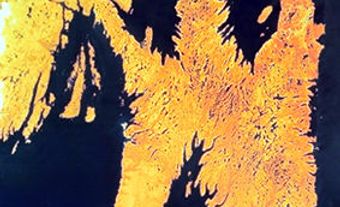Ungava Peninsula
The Ungava Peninsula is a large peninsula approximately 350 000 km2 in area and washed by the waters of Hudson Bay, Hudson Strait and Ungava Bay. The name is of Inuktitut origin and may mean "towards the open water" in reference to the Ungava Inuit who were living at the mouth of the Rivière Arnaud, which flows into Ungava Bay. Peopled along the coastal fringe for centuries by Inuit communities, the interior is a vast, unpopulated, treeless plateau, which attains altitudes of 300 to 600 m. It is underlain by continuous permafrost which attains thicknesses of 200 to 600 m. The peninsula is rich in mineral wealth, mainly asbestos, nickel, copper, uranium and iron ores. This wealth remains largely untapped at present, because of the high costs of extraction and a poor world market. In 1950 a lake about 100 km west of the community of Kangiqsujuaq, was recognized as a meteorite crater. This crater is 415 m deep and 3.4 km in diameter and is known as the Nouveau-Québec Crater.

 Share on Facebook
Share on Facebook Share on X
Share on X Share by Email
Share by Email Share on Google Classroom
Share on Google Classroom

